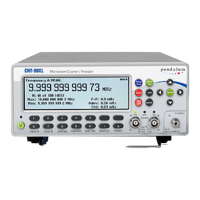Using both start and stop
arming to select the part of the
burst that is of interest.
Use the same test setup as in the preceding ex-
ample. Then proceed as follows:
— Press
SETTINGS Arm and select Stop
Chan E
and negative Stop Slope.
— Measure.
Profiling means measuring frequency versus
time. Examples are measuring warm-up drift
in signal sources over hours, measuring the
linearity of a frequency sweep during seconds,
VCO switching characteristics during milli-
seconds, or the frequency changes inside a
"chirp radar" pulse during microseconds.
These counters can handle many profiling
measurement situations with some limitations.
Profiling can theoretically be done manually,
i.e., by reading individual measurement re-
sults and plotting in a graph. However, to
avoid getting bored long before reaching your
800th or so measurement result, you must use
some computing power and a bus interface. In
profiling applications, the counter acts as a
fast, high-resolution sampling front end, stor-
ing results in its internal memory. These re-
sults are later transferred to the controller for
analysis and graphical presentation. The
TimeView™ software package greatly simpli-
You must distinguish between two different
types of measurements called free-running and
■ Free-Running Measurements
Free-running measurements are performed over
a longer period, e.g., to measure the sta-bility
over 24 hours of oscillators, to measure initial
drift of a generator during a 30-minute warm-up
time, or to measure short-term sta-bility during 1
or 10s. In these cases, measure-ments are
performed at user-selected intervals in the range
2
µ
s to 1000 s. There are several different ways
of performing the measurements at regular
intervals.
Measurements using the statistics features
for setting the "pacing time"
By setting the pacing time to 10 s for example,
measurements are automatically made at 10 s
intervals until the set number of samples has
been taken. The range is 2 - 2*10
9
.Use
HOLD/RUN and RESTART if you want to stop
after one full cycle. You can watch the trend or
spread on the graphic display while the
measurement is proceeding.
Using a controller as a "pacer"
As an alternative, the timer in the controller can
be used for pacing the individual measure-ments.
This allows for synchronization with external
events, for instance a change of DUT when
checking a series of components.
Using external arming signals
External arming signals can also be used for
"pacing." For example with an arming signal
consisting of 10 Hz pulses, individual mea-
surements are armed at 100 ms intervals.
Letting the counter run free
When the counter is free-running, the shortest
delay between measurements is approximately 4
µs (internal calibration OFF) or 8 µs (internal
calibration ON) plus set measurement time. For
example, with a measurement time of 0.1 ms,
5-13
USER MANUAL ● CNT 9x Series ● Rev.22 February 2020

